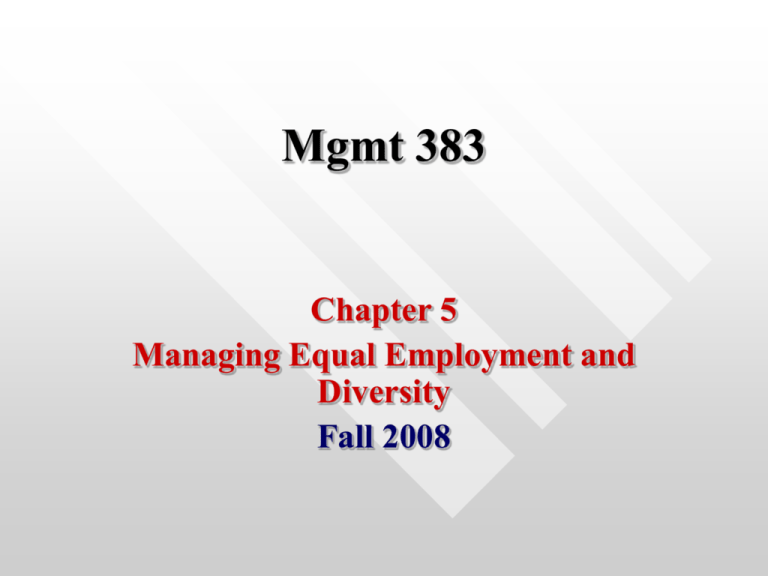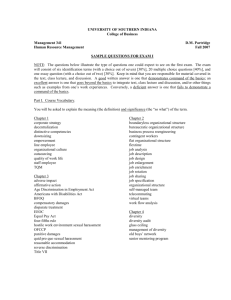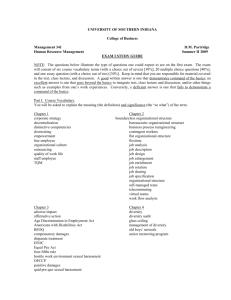
Mgmt 383
Chapter 5
Managing Equal Employment and
Diversity
Fall 2008
Diversity
•
•
•
•
•
Race/ethnicity
Age
Gender
Physical disabilities
Sexual orientation
The Diversity/EEO Paradox
• Diversity – recognizing differences.
• EEO – ignoring differences based on race,
color, religion, sex, national origin, age, and
disability.
Affirmative Action
• Recruitment of underrepresented/
underutilized groups.
• Changing management attitudes.
• Removing discriminatory obstacles
(employment practices creating disparate
impact).
• Preferential treatment.
Developing An Affirmative
Action Plan
• Three general components under
Revised Order No.4:
• (1) Utilization Analysis
• (2) Goals and Timetable
• (3) An Action Plan
Source: 41 C.F.R. Part 60-2
Affirmative Action
• Conditions that must be met in order to be
permissible under Title VII. Steelworkers v. Weber,
443 U.S. 193, 208 (1979):
• Must be justified (remedial).
• Cannot create an absolute bar.
• Cannot unnecessarily trammel the rights of
members of nonfavored groups.
• Must be temporary in nature.
Affirmative Action
• Failure to meet the standards provided in
Steelworkers v. Weber will result in reverse
discrimination.
• Hiring an unqualified individual simply because he or
she is a member of an underutilized group will
establish “reverse discrimination.”
Affirmative Action
• Grutter v. Bollinger, the Supreme Court has
declared that “diversity” can serve as a
justification in college admissions.
• Only deals with state, local, and federal
government programs.
• Note: the applicant must still be minimally
qualified.
• This justification has not been applied to
employment and contract award situations
(yet).
Requirements for Immigrants &
Foreign-Born Workers
• Visas & Work Permits
• Insure that the worker has authorization to work in the
US:
• H-1B for professional employees (good for 6 years).
• L-1 for intra company transfers.
• SSAN and employee name mismatches
•
•
•
•
•
Unreported name change.
Marital status change.
Stolen identity.
Clerical error.
Fraud (likely an illegal alien).
National Origin & English-Only
Rules
• English-Only work rules
• Must be justified.
• Cannot create a universal prohibition.
• Must describe consequences for
noncompliance
• Must be communicated to all employees.
Source: Garcia v. Spun Steak, 13 F.3d 296 (9th Cir. 1993)
Racial/Ethnic Harassment
• Note that in our discussion of sexual
harassment, what applies to sex may be
applied to race, religion, and national origin.
Categories of Sex
Discrimination
•
•
•
•
•
•
Disparate Treatment
Disparate Impact
Sexual Harassment
Sex-Plus
Pregnancy
Pay Differentials
What is Sexual Harassment?
Any unwelcome sexual advances, requests for
sexual favors, or other verbal or physical conduct
of a sexual nature constitutes harassment when:
Submission to such requests is made explicitlyor
implicitly a condition of one's employment (i.e.,
hiring,firing, raises, promotions, etc.).
What is Sexual Harassment?
• Submission to such conduct is used as the basis
for employment decisions.
• Such behavior has the purpose or effect of
"unreasonably" interfering with an individual's
performance on the job or creating an
intimidating, hostile, or offensive work
environment.
Common Examples of.
Sexual Harassment.
Unwanted physical contact, including touching,
pinching, brushing the body, coerced sexual intercourse,
or assault.
Verbal sexual innuendoes, graphic comments
about an individual's body, jokes of a sexual
nature, suggestive comments, sexual propositions,
or threats.
Displays in the workplace of sexually suggestive
objects or pictures
Proofs for Quid Pro Quo Sexual
Harassment
1. The complaining party is a member of a
protected class.
2. The conduct of a sexual nature was
unwelcomed. The complaining party did not
encourage it by word or deed.
3. But for the complaining party's sex, she would
not have been subjected to the unwelcomed
conduct.
Proofs for Quid Pro Quo Sexual
Harassment
4. The complaining party's acceptance or
rejection of the unwelcomed conduct would
affect tangible job benefits.
5. Respondeat superior. When the employer is
liable for the actions of its agents
Since tangible job benefits are involved, only
management personnel can perpetrate quid pro
quo sexual harassment.
Respondeat Superior
• Literally, “let the master
answer.”
• The employer is responsible for
the wrongful acts of its servants
or agents.
Proofs for Hostile Environment
1. The complaining party is a member of a protected
class.
2. The conduct of a sexual nature was unwelcomed. The
complaining party did not encourage it by word or deed.
3. But for the complaining party's sex, he or she would
not have been subjected to the unwelcomed conduct.
Proofs for Hostile Environment
4. The unwelcomed conduct was so severe or pervasive
as to alter the employee’s conditions of employment by
creating an intimidating and adverse work environment.
5. Respondeat superior.
The perpetrator of hostile environment sexual harassment
may be anyone: managers, coworkers, vendors, clients,
customers, etc.
It is Not a Civility Code
• “The prohibition of harassment on the basis of sex
requires neither asexuality nor androgyny in the
workplace; it forbids only behavior so objectively
offensive as to alter the ‘conditions’ of the victim's
employment. Conduct that is not severe or pervasive
enough to create an objectively hostile or abusive work
environment -- an environment that a reasonable
person would find hostile or abusive -- is beyond Title
VII's purview.” Harris v. Forklift Systems, Inc., 510
U.S. 17, 21, citing Meritor Savings Bank, FSB v.
Vinson, 477 U.S. 57, 67.
Recent Developments
• Faragher v. City of Boca Raton and Burlington
Industries v. Ellerth decided on June 26, 1998,
created new federal guidelines for determining
employer liability in sexual harassment
complaints.
• Oncale v. Sundowner Offshore Services, Inc.
decided on March 4, 1998, held that same-sex
sexual harassment is actionable under Title VII.
Employer Liability for
Coworkers
• Direct Liability for sexual harassment initiated by
coworkers, vendors, clients, customers.
• The employer is liable when:
The employer knew, or should have known
(constructive knowledge), that the sexual
harassment was occurring and failed to take
immediate and appropriate corrective action.
Sources: Katz v. Dole, 709 F.2d 251; Barrett v. Omaha Nat’l Bank, 726 F.2d 424.
Employer Liability for
Supervisors
• Vicarious (Indirect, Strict) Liability for sexual
harassment committed by supervisory personnel.
• The employer is liable for the actions of its
agents regardless of whether or not the
employer knew or should have known, of its
agent’s sexual harassment, even after taking
prompt corrective action.
•
Sources: Miller v. Bank of America, 600 F.2d 211 (9th Cir. 1979).
Employer Liability
Quid Pro Quo
By Supervisor
Vicarious (Strict)
Liability
( No Affirmative
Defense)
Hostile
Environment
Vicarious (Strict)
Liability
(Affirmative
Defense)
By Coworkers,
Customers,
Vendors
Not Applicable
Direct Liability
The Faragher/Ellerth
Affirmative Defense
• Faragher & Ellerth permit an employer to avoid
vicarious liability provided they can demonstrate a
two-part affirmative defense:
• (1) The employer exercised reasonable care to
prevent & promptly correct any sexually harassing
behavior, and
• (2) the complaining party unreasonably failed to
take advantage of any preventative or corrective
opportunities provided by the employer or to other
wise avoid harm.
Reasonable Care
• Anti-Harassment Policy is now a necessary,
though not sufficient, part of any affirmative
defense.
• Not only must there be a written policy, it
must be:
• Disseminated
• Consistently enforced
• Train supervisory personnel.
“Unreasonably Failed”
• The second part of the defense is that
employers must also show that the CP
unreasonably failed to avail herself of the
organization’s protective policy &
procedures.
• Show the policy was disseminated.
• Show the policy had been enforced.
• Show the CP was aware of the policy
(documentation).
What is a Manager's
Responsibility?
Understand. Know your company's policies on sexual
harassment, and its complaint and investigation procedures.
Observe.
1. Be aware of what goes on around you.
2. Be conscious of how your subordinates interact.
3. Watch for more subtle forms of sexual harassment and
how they may negatively affect the work and self-esteem
of some of your subordinates.
What is a Manager's
Responsibility?
Model.
1. Set the example of the behavior you
expect from your subordinates.
2. Let your subordinates know that you will
take action if a case of sexual harassment
comes to your attention.
3. Demonstrate your willingness to discuss
the issue.
Investigate. Take all allegations seriously and begin the
formal investigation process upon notification.
Company incentives to
investigate
It violates federal civil rights laws.
Size of Employer’s
Work Force
15-200
201-300
301-500
>500
Maximum Combined Punitive
and Compensatory Damages
$50,000
$100,000
$200,000
$300,000
Failure to do so may diminish the firm's reputation.
Sex Discrimination Terms
• Nontraditional Job - historically male jobs
(construction, factory, mining etc.)
• Glass Ceiling - discriminatory practices that
prevent women from advancing to executive-level
jobs.
• Glass Walls - practices that preclude women from
certain executive-level jobs (i.e., key line
positions).
• Glass Elevator – synonymous with glass walls.
Developments in Age
Discrimination
• Age Discrimination in Employment Act of 1967
(ADEA)
• Even if you replace one >40 employee with
another >40 employee you can still violate the
ADEA if the replacement was based upon age.
• An older >40 employee was replaced by a
substantially younger >40 employee. O’Connor v.
Consolidated Coin Caterers, 519 U.S. 1040
(1996).
Developments in Age
Discrimination
• Age Discrimination in Employment Act of 1967
(ADEA)
• General Dynamics Land Systems v. Cline, 540
U.S. 581 (2004), the U.S. Supreme Court held that
the ADEA only prohibits age-based discrimination
against relatively older individuals.
Religious Discrimination
• Religious BFOQ (§702)
• [Title VII]...shall not apply ... to a religious
corporation, association, educational
institution, or society with respect to the
employment of individuals of a particular
religion to perform work connected with the
carrying on by such corporation, association,
educational institution, or society of its
activities."
Source: 42 U.S.C. section 2000e-1(a).
Religious Accommodation
• Religious Accommodation - In his or her
rebuttal, the employer must show that the obligation
to "reasonably" accommodate the employee’s
religious beliefs and practices was met, or that the
accommodation would impose an undue hardship on
the employer.
• By showing that the employee’s desired
accommodation would impose an undue hardship,
the accommodation becomes "unreasonable".
Source: Chalmer v. Tulon Company of Richmond, 101 F.3d 1012, 1019 (4th Cir. 1996).
Religious Accommodation
• Prima facie case of religious discrimination based on
accommodation by demonstrating that:
(1) the individual has a bona fide belief that compliance
with an employment requirement would be contrary to
his religious beliefs or practice,
(2) the individual informed the employer of the conflict,
and
(3) the individual was disciplined or discharged for failing
to comply with the conflicting employment requirement.
Source: Wilson v. U.S. West Communications, 58 F.3d 1337, 1340 (8th Cir. 1995).
Traditional Training
Approaches to Diversity
• Legal awareness – legal implications of
discrimination.
• Cultural awareness – attempts to deal with
stereotypes through discussion and
exercises.
• Sensitivity training – sensitizes people to
the differences among them and how their
words and behaviors are perceived by
others.
Diversity-Demographic Trends
• The “white” population declined from 76% in
1990 to 69% in 2003.
• Hispanics became the largest ethnic minority
according to the 2000 census.
• Their growth rate was 58% for 1990 to 2003
compared to 13% for the total US population.
• There is a greater need for bilingual
supervisors/managers.
Diversity-Demographic Trends
• Workforce will become older (Mean age: 77.,
men 74.0, women, 80.7)
• The 16 to 24 year-old group will decrease
(fertility rate is 2.08).
• More phased retirement.
• A range of industries will experience shortages
of qualified workers.
• More disabled employee participation.
Effects of Increased Female
Participation
• More flexible work schedules.
• More shared work.
• More part-time work.
• Greater variety of benefits to attract women.
• Child care.
• Maternity leave.
• More job placement for spouses.
• More sex discrimination litigation.
Effects of Ethnic Minority
Participation on HRM
• More training in English as a second language.
• Greater demand for multilingual employees
(especially supervisors).
• More cultural awareness and diversity training.
• Increased ethnic tensions in the work place,
including minority v. minority conflict.
• More discrimination litigation.
Effects of Ethnic Minority
Participation on HRM
• Requisite skill shortages.
• Only 33% of immigrants have a high school
education.
• 800,000 to 900,000 legal immigrants arrive
annually.
• Low skills from Mexico, Sudan, and the
Balkans.
• Inpatriates in technical skill becoming common
(primarily India and Asia)
Effects of Ethnic Minority
Participation on HRM
• Ethnic minorities with college degrees are often
over-represented in low demand areas and underrepresented in high demand areas (from a business
perspective):
• Ethnic minority degrees are over concentrated in:
• Social work
• Liberal arts
• Ethnic studies
Mixed Reviews on Diversity
Training’s Effectiveness
• Draws attention to differences and builds
walls rather than breaking them down.
• Is viewed as being “politically correct” by
focusing on blaming the majority group for
past wrongs that are no longer relevant.






